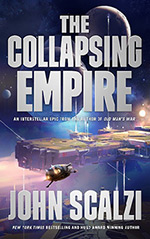
![]() mciocco
mciocco
7/11/2017
![]()
Space is so big that it's difficult for us puny humans to really internalize the distances involved. Voyager 1 is the farthest man-made object from Earth and a few years ago, it became the first spacecraft to enter interstellar space. It's not pointed at any specific star, but for the sake of illustration, let's say that it's headed towards our closest neighbor, Proxima Centauri, 4.2 light years away. At its current speed, it would take Voyager 1 over 70,000 years to reach it.
Again, space is big. Some science fiction takes advantage of this and even manages to generate the fabled sense of wonder from the scale of the universe, but a pretty sizeable portion of the genre is dedicated to shrinking the universe down to a more manageable scale. To accomplish this, science fiction writers wave their hands really, really hard, and we're left with a class of travel known as Faster Than Light (FTL). The special theory of relativity implies that such travel is basically impossible, but science fiction authors need FTL to make certain stories possible. So up yours, Einstein! We've got some exciting space opera to write.
John Scalzi's latest novel, The Collapsing Empire, posits a FTL method called "The Flow", which allows humanity to spread out through the universe to establish colonies on tons of other planets. But the Flow isn't quite as stable as it seems, and thanks to the interdependency of all the planets in the empire, a collapse of the flow system would be catastrophic to the empire. Spoilers, I guess, but hey, it's right there in the title of the novel. As FTL fables go, this isn't exactly original, but Scalzi leverages the tropes well, and spins a fun little space opera yarn that's filled with his usual snappy, page-turning dialog and characters.
Full review linked below:
http://kaedrin.com/weblog/archive/003506.html